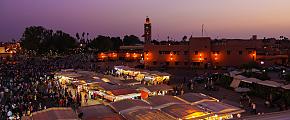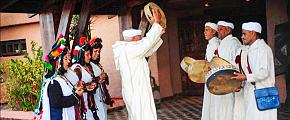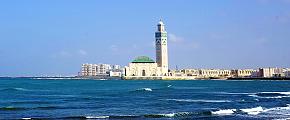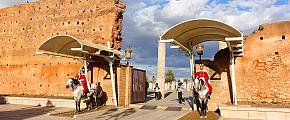Mystical Marrakesh: Top 8 Tourist Attractions to Visit
Situated on the north-west corner of Africa, opposite Gibraltar and Spain,Morocco (Arabic: المغرب, al-maġhrib; French: Maroc), has been a popular visitor destination for centuries. Rich Roman and Greek travelers were drawn to the country 2,000 years ago as have many thousands of others since their time. Sufi pilgrims came in the 17th century, as did writers Paul Bowles and Tennessee Williams in the 1940s, William S. Burroughs, Jack Kerouac and Allan Ginsberg in the 1950s.
Marrakesh (Arabic: مراكش, Murrākuš; French: Marrakech), a Moroccan oasis city located just north of the Atlas Mountains, 239 km / 149 miles south of Casablanca, was founded by the Berbers in 1062. It is considered to be one of Morocco's four imperial cities, the other three being Fez, Meknes and the current capital, Rabat.
Over the years, Morocco has been influenced by the Berbers and Arabs as well as Spanish and French colonialists. All of these cultures have influenced the country and nowhere less so than in Marrakesh, leaving the city with a mystical air and unique ambiance. In the 1960s, Marrakesh became a favourite playground for the Beatles and Rolling Stones and associated glitterati.
Alongside the famous names, millions of less well known people have been visiting this magical city for years, raising the question "Why?" I guess they have had many, many reasons, but here I want to give some of the best reasons for me, in the hope that you'll agree.
Djemaa El Fna ساحة جامع الفناء
Colored cottons hang in the air
Charming cobras in the square
Striped djellabas we can wear at home
Well, let me hear ya now
Would you know we're riding on the Marrakesh Express?
—Crosby Stills and Nash
I'm going to start with the place where Marrakesh's day begins and evening ends. Sometimes alternatively transliterated as Jemaa el-Fnaa, this is Marrakesh's main square. A public square has been on this spot for over a thousand years, but its present form dates from around the 12th century and it took on its present name in the early 17th century. It is located in the heart of the medina (old city). It was declared a UNESCO Oral and Intangible Heritage Site of Humanity on May 18th, 2001.
The square kicks off every day of the week around 8 am when the neighboring souk (market) opens catering for the daily needs of the locals as well as supplying visitors with souvenirs. Then water vendors turn up selling cups of water from leather bags to thirsty Moroccans and tourists in the square. Then the orange juice stalls set up. Shortly after young men with Barbary apes in chains arrive. Then snake charmers. Although these animals are supposedly legally protected against abuse, enforcement seems non-existent.
 Djemaa El Fna in Marrakesh
Djemaa El Fna in Marrakesh
By afternoon, they have disappeared and been replaced by dancing boys from the Berber hill tribe, the Chleuh from the Atlas Mountains. At the same time magicians and storytellers come to perform. I've stood there listening to storytellers, even though I couldn't even tell you which language they were speaking (probably Arabic or Berber), never mind understanding anything. You can see and feel the drama in their faces and gestures and the reaction of the audience.
Then at dusk, it changes again and the square becomes a huge night food market with many stalls offering all the delights of Moroccan cuisine. The air becomes full of the scents of cooking: saffron; mint; almonds; and the local spice mix, ras-el-hanout. Cooks busily prepare couscous, pastilla (meat pies, traditionally made with young pigeons (squab), almonds and spices, especially cinnamon), and tagines (stews made in a special pot, also called a tagine) among many other dishes. Apart from pigeon, beef, lamb and chicken are the most common meats. Morocco is a 99% Muslim country, and pork is not available. Crosby, Stills, and Nash got it wrong when they also sang about "ducks and pigs and chickens call, animal carpet wall to wall" – No pigs! Vegetarian tagines are widely available, too.
By midnight, it's all over. Time to clean up and get ready for the next day, when it all starts up again as it has been doing for centuries. There are hotels right by the square that allow you easy access, but if you are an early-to-bed type person, they probably wouldn't be the best choice. It gets lively.
Villa Oasis & Jardin Majorelle حديقة ماجوريل
Jacques Majorelle (1886-1962) was a French painter and keen amateur botanist who spent many years in Morocco, traveling all over and painting the sights and the people he encountered. In 1923, he bought some land in Marrakesh and in the early 1930s started to build what was to become his dream home, the Villa Bou Saf Saf. In addition to the house, he also created a 2½ acre garden planted with rare and unusual specimens which he collected on his travels.
In 1947, he opened the garden to the public and its fame spread rapidly. Majorelle died in Paris in 1962, shortly after having sold the land and villa. The property changed hands a few times until finally in 1980 it was about to be sold to developers intent on demolishing it to build a hotel. Thankfully, it was bought instead by Yves Saint Laurent and his partner Pierre Bergé, who had first visited the garden back in 1966. They changed the name of the house to Villa Oasis and restored the garden.
 Jardin Majorelle Garden in Marrakesh
Jardin Majorelle Garden in Marrakesh
Today, the beautiful garden is a delight of rare trees, cacti, flowers etc. There are streams and pools with water lilies and the garden has attracted many bird species. In 1980, Saint Laurent died in Paris and his ashes were scattered in his beloved garden. In 2010, the street in front of the garden's entrance was renamed Rue Yves Saint Laurent in his memory. Before Bergé died in 2017, he donated the Villa and Gardens to the newly formed Fondation Pierre Bergé-Yves Saint Laurent, which still owns the property, although it is managed by the separate Fondation Jardin Majorelle.
The garden and the Berber Museum in the grounds (opened in 2011) are both open to the public every day. October 1 to April 30: 8 am to 5:30 pm and May 1 to September 30: 8 am—6 pm. During Ramadan it is open 9 am to 5 pm. Admission is currently 70 Moroccan Dirham (DH) / approx 7 USD for the garden and an additional 30 DH / 3 USD for the museum. Under 12's get in for free and for university students the cost is 35 DH / 25 DH (approx 3.6 USD / 2.6 USD). It is not possible to buy tickets only for the museum.
Sadly, the beautifully preserved and decorated Villa Oasis is not easily accessible to the public. The Four Season Resort Marrakech does offer a "Villa Oasis Extraordinary Experience" allowing guided tours, but this requires a "donation" to the foundation of at least 25,000 DH (approx USD: $2,600; AUD $ 3,800; GBP £2,000). Dinner is extra at 1,800 DH / 187 USD.
Address: Jardin Majorelle, Rue Yves Saint Laurent, Marrakesh. Tel: +212 (0)5 2431 3047.
Yves Saint Laurent Museum متحف إيف سان لوران بمراكش
Nearby, on the same street as the Villa and Garden is the Yves Saint Laurent Museum. This is one of two such museums, the other being in Paris. The Marrakesh museum was built by Pierre Bergé using funds raised by selling Moroccan artworks and opened in 2017. The 4,000 ㎡ / 4,784 sq yard building has changing displays of Saint Laurent's designs and clothes as well as a hall dedicated to the works of Jacques Majorelle. There is a gift shop, bookstore, and café / restaurant.
The museum is open from 10:00 am to 6:00 pm (last admission at 5:30 pm) every day except Wednesdays. During Ramadan from 10 am to 5 pm (last admission at 4:30 pm). Admission 100 DH / 10.5 USD.
Bahia Palace قصر الباهية
The Bahia Palace was built between 1866 and 1867 by the grand vizier Si Moussa Ba Ahmed. It was designed by Moroccan architect El Mekki to be the world's greatest palace. I don't know about that, but it is certainly impressive. The 8,000 ㎡ / 2 acre gardens are equally impressive.
 Bahia Palace in Marrakesh
Bahia Palace in Marrakesh
The luxurious palace features business and administration offices as well as personal space for the grand vizier and his family. Apart from the vizier's personal quarters consisting of a bedroom and private dining room, four identically sized bedrooms were built for each of his wives to ensure equality of rank. His 24 concubines however had to make do with sharing smaller rooms in pairs. There was also a school for the many children which doubled as a mosque when required.
In 1912, the palace became the residence of General Lyautey, then resident general of France in Morocco and used to billet officers of the occupying army who installed modern features such as electricity and heating.
Address: Bahia Palace, Rue Bahia Bab Mellah, Marrakech. Open daily 9 m to 5 pm. Admission: 75 DH / around 8 USD.
El Badi Palace قصر البديع
El Badi Palace (Palace of Wonder) was commissioned by the Sultan Ahmad al-Mansur in 1578 and completed in or around 1593. Originally having 360 rooms, the palace was the height of luxury with Italian marble colonnades and gold and onyx decoration. The palace fell into disrepair around the 1630s and Sultan Ismail Ibn Sharif (reigned 1672—1727) stripped it of most of its treasures to reuse them for his new palace in Meknes. Today, there is a museum in the remains of the complex.
 El Badi Palace in Marrakesh
El Badi Palace in Marrakesh
Address: Ksibat Nhass, Marrakesh. Open daily 9 m to 5 pm. Admission: 75 DH / around 8 USD.
Saadian Tombs مقابر السعديين
The Saadian dynasty reigned over Morocco between 1524 to 1659. Between the 14th and 16th centuries, the necropolis was used as the burial place of many members of the royal family and associated nobles. In the 18th century the Sultan Moulay Ismail wanted to destroy all vestiges of the past but was wary of destroying the necropolis as that would have been considered sacrilegious, so the tombs were hidden instead. They were not rediscovered until 1917 using some of the first aerial photography techniques.
 Saadian Tombs in Marrakesh
Saadian Tombs in Marrakesh
The most impressive tomb of all is the ornate marble resting place of the Sultan's son, Ahmed El Mansour who is buried in the Hall of Twelve Columns. Also of interest is the tomb of Princess Zorha with its epitaph which translates as "This is the tomb of the noble lady, new moon, virtuous marvel."
Address: Rue de La Kasbah, Marrakesh 40000, Morocco Open daily 9 m to 5 pm. Admission: 75 DH / around 8 USD.
Marrakesh Museum – Dar Menebhi Palace متحف مراكش
This small museum was opened in 1997 inside the newly restored, 19tth century, classical Andalusian style, Dar Menebi Palace. The palace was built for a former defence minister, then became a private residence before becoming a girl's school in the 1960s.
The museum itself gets mixed reviews, but many say that the beautiful building itself is much more of an attraction than the exhibits of weaponry, pottery and traditional crafts. Look out for the central courtyard with its huge chandelier, stunning arches and the highly ornate rooms all around the perimeter where the museum exhibits are displayed.
Address: Place Ben Youssef, Marrakesh. Open daily 9 am to 6:30 pm. Admission: 30 DH / approx 3 USD.
Maison de la Photographie
Much more interesting as a museum, if not a venue, is the Maison De La Photographie or, in English, Photography House. This was founded in 2009 by French collector Patrick Menach and his Moroccan friend Hamid Mergani and displays literally thousands of photographs of Morocco and its people, taken between the 1870s and 1950s. There are old glass negatives from the High Atlas Mountains and an opportunity to watch a remarkable, rare, color documentary shot in the 1950s. This is truly a fascinating glimpse into 150 years of Morocco's history and culture, but there are also exhibits of the work of young Marrakesh and other Moroccan photographers who are still documenting their homeland today. Should you fall in love with Marrakesh – a very likely prospect —visit again the next time you come; the exhibits are constantly changing.
Also, despite not being as palatial as the Dar Menebhi Palace, the premises where the photographs are displayed is an attractive restoration of a traditional riad in Marrakech's Medina. At the top of the building is a terrace with a very nice café serving drinks, snacks, tagines and other specialties. There is also a great view over the medina as a bonus.
Note: The building has several floors and there is no elevator, so unfortunately is not suitable for those with mobility issues.
Address: 46, Rue Souk Ahal Fassi, kaat Ben Nahid. Tel: +212 5 2438 5721. Open daily 9:30 am to 7 pm. Admission: 50 DH / approx 5 USD. Under 12s free.
These are my recommendations, but Marrakesh has more to offer than I can cover here. Please remember, Odynovo can custom-make you a tour to Marrakesh and the rest of Morocco as well as over 30 other destinations around the world. Just tell us your dreams and hopes and we'll send you a free itinerary designed just for you.
Quick Question
What Our Clients Say
Explore the latest verified reviews of Odynovo's travel services on Tripadvisor, Google, Trustpilot, Product Review and more trusted platforms.
SUBSCRIBE TO WIN A FREE TOUR
Subscribe to our newsletter for a chance to win a free 7-day tour to India! And more insider travel news, exclusive offers, and inspiration will be sent straight to your inbox. Check our previous newsletters and get some sparks.





